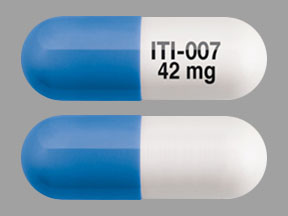Caplyta Interactions
There are 609 drugs known to interact with Caplyta (lumateperone), along with 10 disease interactions, and 4 alcohol/food interactions. Of the total drug interactions, 168 are major, 438 are moderate, and 3 are minor.
- View all 609 medications that may interact with Caplyta
- View Caplyta alcohol/food interactions (4)
- View Caplyta disease interactions (10)
Most frequently checked interactions
View interaction reports for Caplyta (lumateperone) and the medicines listed below.
- Adderall (amphetamine / dextroamphetamine)
- albuterol
- atorvastatin
- bupropion
- buspirone
- clonazepam
- famotidine
- gabapentin
- hydroxyzine
- ibuprofen
- Klonopin (clonazepam)
- Lamictal (lamotrigine)
- lamotrigine
- Latuda (lurasidone)
- levothyroxine
- Lithium Carbonate ER (lithium)
- melatonin
- metformin
- omeprazole
- ondansetron
- pantoprazole
- prazosin
- propranolol
- Seroquel (quetiapine)
- topiramate
- trazodone
- Trintellix (vortioxetine)
- Vitamin D3 (cholecalciferol)
- Vraylar (cariprazine)
- Vyvanse (lisdexamfetamine)
Caplyta alcohol/food interactions
There are 4 alcohol/food interactions with Caplyta (lumateperone).
Caplyta disease interactions
There are 10 disease interactions with Caplyta (lumateperone) which include:
- suicidality
- dementia
- aspiration
- seizure
- hematologic abnormalities
- hyperglycemia/diabetes
- hypotension
- lipid alterations
- hepatic impairment
- tardive dyskinesia
More about Caplyta (lumateperone)
- Caplyta consumer information
- Compare alternatives
- Pricing & coupons
- Reviews (192)
- Drug images
- Side effects
- Dosage information
- Patient tips
- During pregnancy
- FDA approval history
- Drug class: atypical antipsychotics
- Breastfeeding
- En español
Related treatment guides
Drug Interaction Classification
| Highly clinically significant. Avoid combinations; the risk of the interaction outweighs the benefit. | |
| Moderately clinically significant. Usually avoid combinations; use it only under special circumstances. | |
| Minimally clinically significant. Minimize risk; assess risk and consider an alternative drug, take steps to circumvent the interaction risk and/or institute a monitoring plan. | |
| No interaction information available. |
See also:
Further information
Always consult your healthcare provider to ensure the information displayed on this page applies to your personal circumstances.


